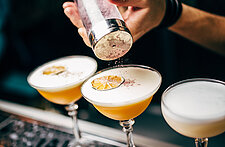This is part 2 of the Symrise interview with Chef Rodolfo Cuadros of Carnivale, Chicago.
Chef Cuadros was interviewed by Emmanuel Laroche, Symrise’s Senior Vice President, Marketing & Communications, Global Marketing Leader. Chef Cuadros is known for the Latin-inspired dishes which he creates at Carnivale, located in Chicago’s West Loop. Growing up in Cali, Colombia, young Rodolfo enjoyed helping his mother and his aunts in their busy kitchens, assisting them as they prepared traditional favorites for holiday celebrations. Years later, he earned a Culinary degree from Johnson and Wales University, and went on to delight diners at restaurants in worldwide locations. He is an expert in the nuances and ingredients of varied Latin American cuisine which he adapts to create unique Pan Latin dishes at Carnivale.
Emmanuel Laroche: What are some of the other ingredients or dishes that you wish were available here in the states?
Rodolfo Cuadros: One ingredient that you can’t really find here is macha – which is traditional in Chile. It is similar to clam but macha tend to be a little bigger than the surf clams found in California. Then there’s a South American mushroom called ciampa that grows in woody areas close to shores, and frequently found in Chile and Argentina. It’s a mix between a morel and a black trumpet with earthy tones and woodsy flavor and grows to a very large size. I’ve only been able to get them frozen. In Colombia, we had guava trees and guanabana and lulo trees – many different trees which grew near our homes. There are so many different varieties of fruit around the world. I have heard it said that you can eat one fruit for each single day of your life and you still will not have eaten them all. Many unique fruits come from South America but it is impossible to get these here. It would be wonderful to introduce some of these delicious fruits to mainstream Americans. When it comes to ingredients found in drinks, in Colombia I drank just natural fruit juice, never soda.
EL: I strongly believe that guanabana is one of those fruits that could become more popular in the U.S. – what do you think?
RC: I love guanabana. There was a tree right next to my grandmother’s house. I used to climb the tree to get this spiky fruit that has many health benefits, so many good fats and sugars. It’s a shame that we get only get them frozen. In Miami, you can find a couple of these trees. There’s also zabala fruit – so unique – a starchy fruit that is dry and very sweet. It would be great if we could expose these fruits to Americans here in the States.
CLICK HERE to view Culinary Chronicles, written by the chefs at Symrise
EL: What do you believe is the biggest misconception that people have about Latino cuisine?
RC: The idea that all Latino food is spicy. In Argentina, food isn’t spicy and in Chile, just some regions have spicy food. In Peru, food tends to be very spicy. In Ecuador, food is on the mild side as it is in Colombia. Even in Mexico, there are areas where the food is not all spicy. I find this misconception in my own family. My wife’s mother is Cuban and her father is French Canadian. When we meet with her French Canadian side, they will say, ‘Cook something but don’t make it spicy’. I think people confuse spicy hot foods with Hispanic food that is packed with flavor. Every chef is motivated to make his own creation because there are so many different layers of flavor in Hispanic food, another reason why its popularity will continue to grow.

EL: We have seen the growing popularity of the Argentine steak houses, and the influence of Peru and Brazil, what do you regard as the upcoming trend in U.S. restaurants?
RC: The Argentine influence will keep growing because of this country’s insatiable appetite for meat but I really wish we would eat more grass-fed beef. I know that the whole U.S. industry is based around grain and antibiotics. I lived in London for more than a year and I worked at a place called Gaucho Grill. It’s owned by an Argentine company that maintains its own land where they raise their own cattle. I think grass-fed beef is under appreciated in the U.S. and I wish we could use more beef from Argentina, Uruguay and Chile. Brazilian cuisine is concentrated around meat and will only continue to grow. We need to do a better job in putting quality ahead of quantity based on the grass-fed concept. Sometimes, we get caught up in chain restaurants that can give the wrong impression of Hispanic food. As Hispanics, we should be promoting Hispanic food as a whole to create appetizers, side dishes and entrees that represent different cultures and that rely on different ingredients. When we treat Latin cuisine as a whole cuisine, we educate the most amount of people in the least amount of time. I personally love the Pan Latin concept which we feature at Carnivale and I would like to keep expanding it. For example, we use the Brazilian influence when we make Arrachera, a steak stew. We give a Peruvian touch when we make a traditional ceviche mix and use an Ecuadorian twist as well. We expose people to a huge variety of different cuisines all in one menu.
CLICK HERE to view our INFOGRAPHIC: Latin Flavors on the Menu
EL: I understand the influence of meat but which vegetables do you think represent Latino cuisine in general?
RC: I think corn will always be a key ingredient because there are so many ways of using maize, the Indian word for corn. It is vital to our culture, used in Mexico and in different countries in South America. I would also like to see yucca grow in popularity. Plantain is growing and will continue to do so. It’s a shame that we don’t use green plantains more - they are crunchy and salty. And I love the oil used in Brazil, palm tree oil, which is Dende oil. I also think that Brazilian hearts of palm are amazing. I had a raw hearts of palm salad when I was there. I thought to myself, ‘I wish I could make this’, but it is impossible to get high quality hearts of palm. Also when I went to Peru I met with this chef who is a specialist in Amazonian cuisine. Maybe we’ll begin to see it here.
EL: Which breakfast items at Carnivale are likely to take hold in the U.S.?
RC: Breakfast is universal and what’s missing here in the States are natural, fresh eggs and freshly made beans. In Colombia we would take our leftovers – rice, lentils, beans and add scallions and eggs. It’s called re-calentado. When you take time to make these things to begin with, you can combine what remains with eggs and use them in sandwiches. Even using sea food in breakfast chili dishes is great. Chilaquiles also make a great breakfast dish. I wish more people did it right. We use a green sauce and Oaxaca cheese. When we make carnitas chilaquiles, we use slowly cooked pork. We crisp up the pork in a little oil and then we add fresh corn tortilla, tomatillo salsa, fresh farm eggs and can add a green msauce made with onion, parsley. It’s very popular because it is quite delicious!
Follow Carnivale on Twitter: @Carnivale312
carnivalechicago.com




